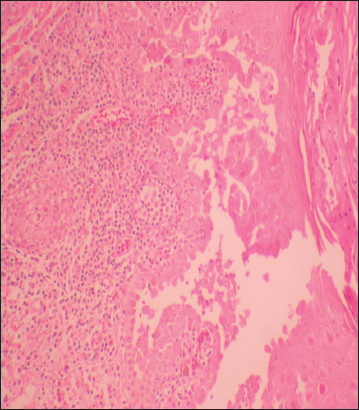A case of Hailey-Hailey disease
Salsabil Attafi, Olfa Khayat, Aschraf Debbiche
Department of Pathology, Habib Thameur Hospital, Tunis, Tunisia
We report a 48 year-old man with a family history of hailey-hailey disease who had outbreaks of rashes and blisters of the neck, axillary (Fig. 1) and inguinal folds. These lesions were recurrent every year. The histological examination of skin biopsy revealed intraepidermal and suprabasilar acantholysis (Fig. 2). Elongated papillae extend into lacunae, and a single layer of basal cells lines the villi (Fig. 3). The diagnosis of Hailey-Hailey disease was retained and the patient was treated by disulone.
Figure 1: Erythematous and cracked plaques of the armpit.
Figure 2: Intraepidermal and suprabasilar acantholysis, (HE x 20)
Figure 3: Elongated papillae or villi lined by a single layer of basal cells, (HE x 40)
Prior to the study, patient gave written consent to the examination and biopsy after having been informed.
Hailey–Hailey disease, or familial benign chronic pemphigusor familial benign pemphigus is a rare hereditary blistering skin disease. It can occur at any age but usually appears in the third or fourth decade. Clinically, it typically begins as a painful erosive skin rash in the skin folds. The lesions may come and go and usually heal without scarring. Common sites include the armpits, groins, and neck, under the breasts and between the buttocks. The genetic defect responsible has now been identified on a gene called ATP2C1 found on chromosome 3q21-24. Usually Hailey-Hailey disease is diagnosed by its appearance and the family history. Diagnosis may require a skin biopsy. There is no specific treatment and the underlying genetic defect cannot be altered; however, treatment does help and long remissions are common.
CONSENT
The examination of the patient was conducted according to the Declaration of Helsinki principles.
Notes
Source of Support: Nil,
Conflict of Interest: None declared.



Comments are closed.